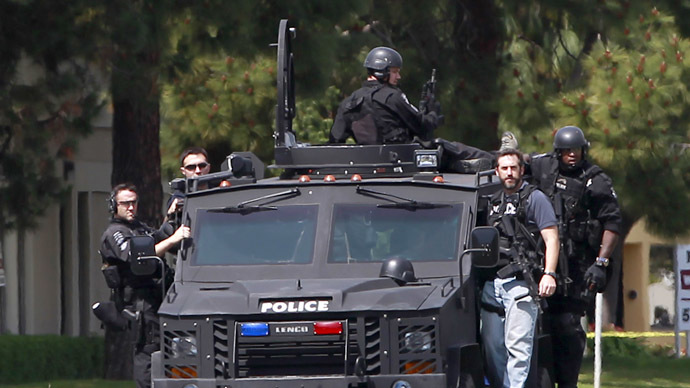Magnum force cops: ‘If you’re holding a hammer, everything looks like a nail’

US law enforcement is increasingly using military weapons for everyday tasks. Instead of hiding behind heavy armor, they should be building trust with the community, Peter Bibring, attorney for the ACLU of Southern California, told RT.
RT:It has recently emerged that the Pentagon and Justice Department contradicted each other in terms of weapons supplies given to police. How can two government branches act in such an uncoordinated way?
Peter Bibring: Unfortunately very easily. One of the problems that we have had with the 1033 program – which is the Department of Defense program to give surplus military equipment to local police agencies – is that it is fairly unregulated. There is not a lot of scrutiny given to local law enforcement’s requests for equipment why they would actually need them. And what has recently emerged is that there is not a lot scrutiny given to local law enforcements history of potential legal violations.
We have seen that one arm of the federal government may actually have sanctioned a local department and brought it under federal control because of the history of abusive conduct. Another arm of the federal government, the Defense Department, may actually be giving the same department surplus of military gear, including fairly heavy weapons and equipment without coordinating, without realizing that there is a history of problems and that some additional scrutiny may be necessary.
RT: How dangerous is this negligence?
PB: It is certainly troubling. What we have seen in departments across the country is that with programs like this giving of military weapons to local law enforcement, local law enforcements are increasingly using those weapons for everyday purposes.
For example, SWAT (Special Weapons and Tactics) teams were originally created 30-40 years ago to deal with situations like active shooters… or taking hostages or barricading themselves in a building and shooting people who came in.
What we have seen that those teams over the past few years have increasingly been used for ordinary law enforcement jobs such as serving search warrants or serving arrest warrants. And in fact a study done by SLU (Saint Louis University) this past summer showed that more than 80 percent of deployments of these SWAT teams were for execution of search warrants overwhelmingly in drug cases.
READ MORE: Reading, Writing and…M16s: US education getting schooled over militarization
RT: The Justice Department has censured some local law enforcement agencies for civil rights violations. What were these violations?
PB: The Justice Department has a program of suing local law enforcement agencies when there is a pattern or practice of constitutional violations. And those violations can range from patterns of discrimination to excessive force, to corruption and the manufacture of evidence or wrongful arrests. And it varies agency by agency what that can be for. But that doesn’t happen in the case of systemic problems in a local agency. So for an agency that is under that kind of federal supervision to be receiving assault weapons or other kinds of military equipment from a federal government without special scrutiny as to how they will be used, how there will be protections against abuse. That is really troubling.
RT: Do you think providing police with lethal weaponry is generally reasonable?
PB: It’s a good question. I think it basically illustrates that there hasn’t been a lot of transparency about these programs. What happens is that law enforcement requests for this kind of equipment are essentially grant applications. So they are done on the level of funding and procurement. They are not a policy decision made by elective officials in a public setting.
One of our concerns has been that the community, the public doesn’t have input on what they want their local police department to adopt these kinds of equipment and tactics. And instead it is a decision made on a sort of bureaucratic level about what equipment will be purchased. What we have seen is that local agencies are getting equipment like assault rifles, grenade launchers, mine-resisting armor protecting vehicles. Sometimes… there is no clear explanation for why they would possibly use them. Here in Los Angeles, for example, not only has LAPD which is a Los Angeles Police Department, a very large department, got the equipment like this. But tiny departments have gotten equipment including assault rifles.
There may be only a few officers in the department. There are departments in this country that have been given more assault rifles than there are officers in the department. Here in LA, our local schools have a police department that is supposed to police school campuses. Though it is designed for schools, it received a Mine Resistant Ambush Protected (MRAP) vehicle as well as assault rifles and grenade launchers. Since that military equipment has come to light they have returned at list the vehicle. But it raises the question why they sought it in the first place.
RT: This program of providing local law enforcement agencies with lethal weapons was authorized in the 1990s. How come the reports about its drawbacks have emerged only now?
PB: Our concern about the program is that there hasn’t been clear justification for why this kind of equipment is necessary, nor have there been protections in place to ensure that it doesn’t get used improperly. There may be extremely unusual situations where police need unusual weapons. But there need to be policies in place to make sure that those weapons aren’t used in course of the ordinary law enforcement.
There is a saying that if you are holding a hammer everything looks like a nail. It is supposed to express that when you are have a particular set of tools you try to find ways to use those tools, and when those tools are military equipment that is not a solution that lends itself to local law enforcement. Local police should be building trust with community and they shouldn’t be hiding behind heavy armor, assault rifles and military vehicles.
The statements, views and opinions expressed in this column are solely those of the author and do not necessarily represent those of RT.












